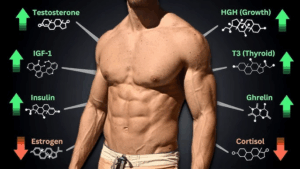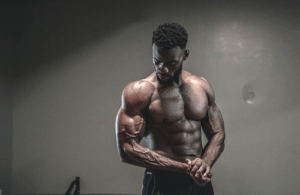How Long Do I Need to Take HGH for Bodybuilding?
People often ask how long to take HGH for bodybuilding, hoping for a simple number of weeks or months. Human growth hormone is a prescription medication that has a strong metabolic, fluid, and glucose-regulating effect. Besides the doctor-prescribed therapy, self-dosing may cause some side effects and legal complications.
Consulting a licensed clinician, who may require a review of your medical history, lab results, and specific objectives, is the safe first step in considering HGH for muscle gain, as well as to determine whether it is the appropriate option for you. This guide can elaborate on how HGH works, what athletes generally refer to when they discuss the time-based results, and what kind of health tests doctors often prescribe (IGF-1, fasting glucose, lipids, thyroid, and others).
It is not going to provide dosing schedules or instructions on cycles. If you are willing to a safety-first low-carb version, that centers around physiology, schedules observed in the medical world, risk awareness, and training/nutrition programs, providing consistent progress without hormones, we can proceed with that.
How Does HGH Work for Bodybuilding and Muscle Growth
The pituitary gland makes human growth hormone (HGH) and signals the liver and tissues to produce IGF-1. IGF-1 supports protein synthesis and the growth and repair of muscle fibers after training. It also influences satellite cells around muscle fibers, which helps muscles adapt to regular load. Alongside this, HGH shifts fuel use toward fats by increasing lipolysis, which can change body composition over time when nutrition and training are on point.

HGH also alters water balance and glucose control, which is why physicians monitor fasting glucose, A1c, thyroid, lipids, and IGF-1 levels when prescribing it. The progress is gradual: initially, training becomes more predictable, next comes a trimmed body fat and recovery during the workout, and later, you can see the difference in muscle structure.
How long to take HGH for bodybuilding? Answers vary depending on sleep, calories, protein intake, and training program. The decision to take or not take growth hormone, to start or stop taking it, should be made in a clinic under the supervision of a licensed professional who will assess the risks, conduct laboratory tests, and determine whether it is necessary to take it. Continuous improvement, with or without hormones, is based on sensible training and recovery.
Benefits of Taking HGH for Muscle Building
Used under medical supervision, reported benefits tend to show gradually and depend on training and diet. Common goals include:
- More strength on repeat sets as recovery between sessions improves.
- Increases in lean mass with consistent protein intake and progressive overload.
- Faster tissue repair after hard sessions, which helps you keep a steady schedule.
- Lower body fat over time due to higher fat use during rest and activity.
Many notice the first changes around 3-4 weeks (sleep quality, less soreness), with body composition shifts following later. Timelines vary, and regular lab checks are important to track response and safety.
How to Take HGH for Bodybuilding – Proper Dosage and Cycle Length
We can’t give dosing or cycle instructions. HGH is a prescription medicine that changes glucose control, fluid balance, and IGF-1, so any plan must come from a licensed clinician after labs and a health review. If you’re researching how to take HGH bodybuilding or how to take HGH for bodybuilding, the safe route is a medical consult where a doctor decides whether therapy is appropriate, sets the plan, and monitors you.
What to expect in a clinic visit for HGH bodybuilding: a discussion of goals, screening for conditions that make HGH unsafe, baseline tests (IGF-1, fasting glucose/A1c, lipids, thyroid panel), and a training/nutrition check so you’re not chasing results.
How Long to Take HGH for Bodybuilding Safely
A clinician determines the length of time when he or she observes your response. Medical workers tend to reexamine during the initial check-ins, test IGF-1 and glucose, and make a decision to continue, have a break, or cease. If you’re asking how long to take HGH for bodybuilding, think in terms of monitored blocks with breaks rather than an open-ended run.

Safety-first plan: run regular labs with blood pressure and weight checks; track edema, numbness/tingling, joint pain, and sleep changes. If side effects appear or IGF-1 rises above the target, taper or stop. Keep training quality, protein intake, and recovery steady so gains hold after treatment ends.
How Long Does It Take for HGH to Show Results in Bodybuilding
Response speed varies, but most reports follow a steady arc when training, sleep, and nutrition are dialed in — and labs are monitored. In weeks 1-2, many notice smoother workouts and a small lift in morning energy. By weeks 4-6, weight may hold while the mirror shows mild changes in muscle fullness and water balance; recovery between hard sessions often improves. Weeks 8-12 bring steadier strength on repeat sets and clearer muscle shape; past week 16, the goal is maintaining gains rather than chasing spikes.
Because glucose control, fluid shifts, and IGF-1 differ person to person, clinicians schedule check-ins, watch for edema, numbness/tingling, joint discomfort, track IGF-1, and adjust or stop therapy as needed. If progress stalls despite good training and protein intake, more hormone isn’t the answer — reassess workload, sleep, and calories with your coach and healthcare provider. Safety checks keep you moving without setbacks.
How to Maintain HGH Results After the Cycle
The end of a supervised course should be followed by lock-in progress through routine and recovery. Incorporate protein regularly (about one protein source per meal), maintain a consistent training frequency, and schedule deload weeks so that tendons and joints remain aligned with the weight being lifted.
Minor supplements, such as creatine monohydrate, a sufficient amount of carbohydrates during training, and eight hours of sleep, assist in maintaining constant strength and muscle mass. Limit cardio long sessions to late hours, which disrupt recovery; shorter and frequent sessions are better.

Maintain a simple supplement and laboratory plan that has been authorized by your clinician, particularly if you have had alterations in glucose or lipids. Lastly, quantify what is important- body measurements, training logs, and weekly photos- in order to make changes based on facts and not on assumptions.
When to Take HGH – Best Timing for Bodybuilding Results
The optimal time for taking the medication is determined individually by a doctor after tests and examination. In reality, physicians are concerned with consistency, glucose regulation, sleep habits, and training regimen as opposed to a universal clock. They can work around the time of day to minimize sleep disturbance. They should avoid overlapping with other medications that affect blood sugar and should not inject immediately after a large evening meal, as this may attenuate the desired effect.
The number of training days and rest days may be treated differently, depending on your tolerance for training, sessions, recovery, and appetite. Regardless of the plan selected, it is at follow-ups that IGF-1, fasting glucose/A1c, lipids, blood pressure, and edema, tingling, or joint pain notes are taken. When to take a particular block of workouts or travel? Request a written schedule of your prescriber to be able to keep right on schedule and safe.
Common Mistakes When Taking HGH
Before starting, remember that HGH is a prescription drug and plans belong in a clinic with labs and follow-ups. Most problems come from chasing speed instead of steady habits. Here are the pitfalls people run into most often and how to avoid them.
- Skipping medical supervision. Self-directed use hides problems and makes them harder to catch early.
- Jumping doses fast or changing schedules often. Bigger numbers rarely equal better results and tend to raise side effects.
- Ignoring labs. IGF-1, fasting glucose/A1c, lipids, and thyroid markers guide safe adjustments.
- Inconsistent routine — missed injections, poor sleep, and erratic meals make outcomes unpredictable.
- Weak training and nutrition basics. Low protein, random calories, and no deload weeks stall progress regardless of hormones.
- Overlooking symptoms: swelling in hands/feet, numbness or tingling, headaches, joint pain, or vision changes need prompt medical review.
- Mixing with drugs or supplements that affect glucose or fluid balance without telling your clinician.
After these have been checked, you should return to the basics of a clean program, proper protein intake, quality sleep, and scheduled accountability. If something is not “right,” wait a moment and discuss it with your prescriber before making changes.
Is Long-Term HGH Use Safe for Bodybuilding?
Long runs belong in medical care. HGH affects fluid balance, glucose, and IGF-1, so physicians monitor labs and symptoms closely during extended therapy. The approach stays conservative: confirm a clinical indication, establish baselines, and reassess progress at each visit.
If swelling in hands or feet, tingling, or joint pain appear — signs that can also overlap with overdose growth hormone risk — prescribers adjust or discontinue treatment. People with a history of diabetes, sleep apnea, certain cancers, or uncontrolled thyroid disorders need extra screening before any therapy begins.
Risk isn’t one-size-fits-all. The picture varies with dose, duration, age, training stress, and sleep. Clinicians integrate blood work (IGF-1, fasting glucose/A1c, lipids, thyroid markers) in conjunction with simpler exams (blood pressure and body weight) for this reason.
They also consider the real-life outcomes: Can a stable program be maintained without edema, numbness, headaches, or vision changes? In the event of a drift in the answer, they stop and reconsider. The most risk-averse long-term strategy makes the horizon humble: train and gain strength and muscle with nutrition, and then accept hormone therapy as a medical choice instead of a downcut.
How Long Should You Take HGH for Bodybuilding Results
There isn’t a universal timer. Doctors set the duration after seeing how you respond to training, sleep, and nutrition, then weigh that against labs and side effects. Many athletes asking how long to take HGH for bodybuilding really want a plan that protects health while making progress. In practice, that means a monitored block with scheduled check-ins, followed by a break if labs or symptoms suggest it. Expect results to build gradually; the goal is steady training, comfortable recovery, and stable markers rather than chasing rapid jumps.
If you and your clinician decide to stop, maintain the structure to ensure progress: include protein at each meal, follow a program with planned deloads, get eight hours of sleep, and incorporate modest cardio that doesn’t overtax recovery. Re-evaluate every few weeks with logs and simple measurements. If performance stalls, look to workload, calories, and technique before considering another medical course.
